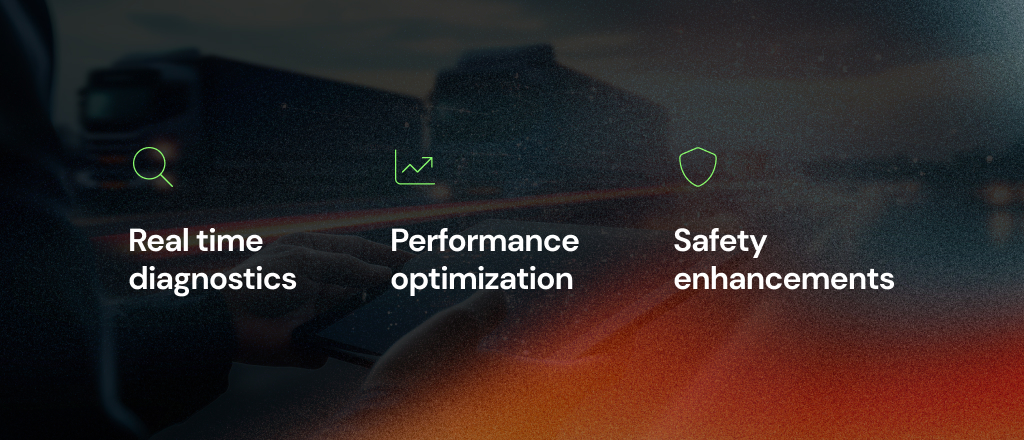
IoT / Telemetrics
CAN Bus Data in Telematics:
a Practical Introduction
Telematics is taking modern logistics and fleet management by storm, and it’s easy to see why.
96% of companies using telematics surveyed by Teletrac Navman reported measurable savings, and almost half integrated AI-driven automation tools into their fleets.
At the heart of this transformation is the Controller Area Network (CAN) Bus, the backbone of vehicle data communication. It powers various telematics applications by enabling vehicles’ Electronic Control Units (ECUs) to exchange information efficiently.
Understanding and using CAN Bus is essential to improving fleet efficiency and safety. This article explores this technology, explaining its role in telematics, challenges in implementation, and best practices for effective integration. Read on!
Zooming in on CAN Bus data
The CAN Bus system stands out due to its ability to exchange information between various ECUs in a vehicle, without requiring a central control unit.
This decentralised communication model is similar to how the human nervous system sends signals throughout the body, enabling vehicle components to function harmoniously.

The major benefits of CAN Bus in telematics
- One of the key benefits of CAN Bus is its ability to reduce wiring complexity and costs, while enabling smooth data communication between vehicle components.
- Its single access point facilitates centralised diagnostics and configuration that streamline vehicle maintenance.
- This protocol is highly reliable, even in challenging environments with electrical interference, which makes it perfect for safety-critical applications.
- Moreover, it enables prioritisation of information, guaranteeing time-sensitive data transmission and enhancing overall performance.
The key technical aspects of CAN Bus:
- CAN Bus is message-based: Unlike traditional communication systems reliant on direct connections, CAN Bus transmits data through message frames. As a result, all ECUs in the network get relevant data without requiring direct point-to-point connections.
- Multiple transmission rates: CAN Bus supports different baud (data transmission) rates, usually ranging from 125 kbps to 1 Mbps. CAN FD (Flexible Data Rate) extends bandwidth capabilities, enabling faster data transmission.
- Error detection and fault tolerance: CAN Bus ensures reliable data transmission through advanced error-checking methods that prevent corruption, such as CRC (Cyclic Redundancy Check) and bit stuffing. These techniques help maintain data integrity, even in challenging conditions.
The role of CAN BUS data in modern vehicles and fleets
In modern vehicles, CAN Bus is the enabler for several critical functions, such as real-time diagnostics, performance optimization, and safety enhancements.
From fuel injection systems to advanced driver assistance systems (ADAS), the ability of ECUs to communicate via CAN Bus ensures that all components work together seamlessly, maximising vehicle efficiency and safety.
For an individual vehicle, CAN Bus is the critical enabler of the following:
- Real-time diagnostics: it facilitates continuous monitoring, enabling detection of malfunctions and reducing repair costs.
- Safety enhancements: critical functions such as anti-lock braking systems (ABS) and electronic stability control (ESC) depend on communication via CAN Bus.
- Optimised performance: it improves fuel efficiency and extends vehicle life by enabling real-time adjustments to engine and fuel systems.

As fleet sizes grow, CAN Bus enables operators to collect and analyse data from thousands of vehicles. This feature allows for predictive maintenance, performance optimisation, and trend identification, all of which help reduce costs and improve fleet efficiency.
Top telematics applications powered by CAN Bus
1. Predictive maintenance
By using CAN Bus data, telemetry solutions can continuously monitor vehicle conditions, identifying early warning signs of failure. This proactive approach allows fleet managers to schedule maintenance tasks, reducing costly downtime and prolonging vehicle lifespans. Read more about predictive maintenance in this use case.
2. Optimising fuel efficiency
Tracking real-time fuel consumption, idle times, and engine load helps fleet operators implement strategies for reducing operational costs and minimising carbon footprint.
3. Driver behaviour monitoring
CAN Bus enables detailed driver behaviour analysis, including harsh braking or excessive acceleration. Insights from this data can enhance driver training programs and improve road safety.
4. Remote diagnostics
By remotely accessing live CAN Bus data, fleet operators can detect vehicle issues in real-time, eliminating unnecessary service stops and reducing related costs.
5. Fleet performance analytics
Aggregating CAN Bus data across multiple vehicles allows fleet managers to benchmark performance, detect inefficiencies, and optimise operations on a fleet scale.
Yet despite the unquestionable advantages of CAN Bus, its implementation isn’t always a walk in the park. Below, we discuss the most frequent challenges you may face when working with this protocol.
CAN Bus in telematics: common challenges with solutions
Luckily, there is a solution to every problem. By sticking to industry best practices, you can reduce or eliminate the impact of all these issues–and here’s how:
1. Data standardisation & signal decoding
Problem: Different vehicle manufacturers use proprietary CAN signal mappings. This feature often requires reverse engineering or manufacturer-supplied Database CAN files.
Best practice: To decode proprietary signals, use standard Fleet Management System (FMS) protocols for commercial fleets or manufacturer-supplied Database CAN (DBC) files.

2. Managing and processing high data volumes
Challenge: CAN Bus generates large volumes of high-frequency sensor data. This information requires efficient processing mechanisms to avoid network overload and incurring excessive storage costs.
Best practice: Consider edge computing solutions. They enable preprocessing data before its transmission, filtering out redundant information and compressing large datasets for more efficient cloud storage and analysis.

3. Security risks & cyber threats
Challenge: The CAN Bus protocol lacks built-in authentication. This feature potentially makes it an easy target for unauthorised access and cyberattacks.
Best practice: Secure data transmission using encryption, firewalls, and intrusion detection systems. Ensure compliance with security standards like ISO 21434 for cybersecurity in road vehicles.

4. Integration with telematics platforms
Challenge: Converting raw CAN Bus signals into actionable insights requires robust APIs and middleware solutions.
Best practice: Make conscious software and hardware decisions. Design scalable architectures using RESTful APIs and MQTT to enable seamless data exchange between CAN Bus hardware and telematics platforms.
N.B.: If your team lacks the required expertise, enlist an experienced telematics software consultant to get your project off the ground.

5. Compliance and future scalability
Challenge: As fleet sizes grow and regulatory requirements evolve, telematics solutions must remain adaptable. CAN Bus may struggle with scalability due to its limited bandwidth and lack of built-in security mechanisms.
Proprietary signal mappings can also complicate catching up with changing regulations.
Best practice: Adopt modular and scalable telematics solutions that support CAN FD or Automotive Ethernet for higher data throughput. Secure communication protocols (TLS, VPN) ensure compliance with changing regulations, while modular telematics systems provide scaling room for growing fleet demands.

The future of CAN Bus: four trends to reckon with
As vehicles become more connected and smart, the role of CAN Bus will surely continue to evolve. Here are the four largest trends already at play:
1. Growing usage of AI & Machine Learning
AI-powered predictive analytics are revolutionising fleet management. As algorithms become more advanced, CAN Bus-enabled telematics systems will help to deliver more accurate diagnostics and predict failures earlier.
This trend will clearly continue to grow, and according to market predictions, the value of AI in automotive will exceed $19 billion by 2032.
2. Wider adoption of CAN FD
Offering higher data transmission speeds and sizes, CAN FD is poised to boom as the demand for advanced driver assistance systems (ADAS) and autonomous vehicles grows.
The CAN FD market is predicted to expand at a CAGR of over 11% from 2025 to 2033 when it will exceed $750 mln.
3. Growth of Vehicle-to-Everything (V2X) communication
V2X communication is set to revolutionise road safety and traffic efficiency by enabling real-time data exchange between vehicles and infrastructure. CAN Bus is a crucial facilitator of this shift, as it allows for seamless integration with intelligent transport systems.
As governments encourage V2X adoption—like the European Union’s C-ITS initiative—fleets using CAN Bus telematics will likely gain a competitive edge in safety and compliance.
4. The rise of Software-Defined-Vehicles (SDVs)
Software-defined vehicles (SDVs) refer to controlling and updating vehicle functions through software rather than hardware modifications. According to Deloitte, SDVs will account for 90% of the new vehicle market by 2029.
CAN Bus plays a vital role in this transformation. Enabling over-the-air (OTA) updates, automation, and AI-driven vehicle optimisation helps create more adaptable vehicle architectures while reducing reliance on mechanical updates.
Instead of a conclusion
CAN Bus is the backbone of modern telematics, enabling real-time insights, improving fleet efficiency, and supporting critical applications like predictive maintenance and monitoring.
Embracing this technology is not just a technical decision but a strategic one, as it can unlock significant cost savings and new operational efficiencies.
While issues like data standardisation and security often prove problematic in CAN Bus implementation, industry best practices usually mitigate them.
Ready to optimise your vehicle and fleet management with CAN Bus? Contact us for a bespoke telematics solution to boost performance, reduce costs, and secure future scalability.




